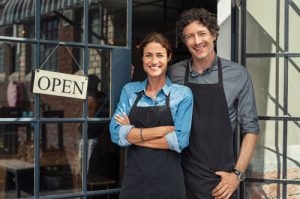Good food hygiene is essential for any business that makes or sells food. As such, it is vital for you and your staff to understand what good food hygiene is.
The easiest way to ensure good food hygiene is to use the four C’s of food hygiene, outlined by the Food Standards Agency.
The four C’s of food hygiene are:
- Cross-contamination
- Cleaning
- Chilling
- Cooking
Cross-contamination
Cross-contamination occurs when bacteria is spread between food, surfaces or equipment. The most common way this occurs is when raw food touches or drips on to ready-to-eat food, equipment or surfaces.
To prevent cross-contamination, you should ensure the following things are done:
- Clean and disinfect work surfaces, chopping boards and equipment thoroughly before and after you prepare food.
- Use different equipment for raw meat/poultry and ready-to-eat food unless they can be heat disinfected.
- All staff wash their hands before and after preparing food.
- Always keep raw and ready-to-eat food separate, including packaging material for ready-to-eat food.
- Store raw food below ready-to-eat food in the fridge. If possible, use separate fridges for raw and ready-to-eat food.
- Provide separate working areas, storage facilities, clothing and staff for the handling of ready-to-eat food.
Make sure that your staff know how to avoid cross-contamination.
Cleaning
Effective cleaning of hands, equipment and surfaces ensure bacteria is eliminated. This helps to stop harmful bacteria from spreading onto food. To ensure effective cleaning, you should do the following things:
- Ensure all staff wash and dry their hands thoroughly before and after handling food.
- Clean and disinfect food preparation areas and equipment between tasks, especially after handling raw food.
- Clear away equipment and clean up as you work, cleaning work surfaces thoroughly.
- Use cleaning and disinfection products that are suitable for the job, and follow the manufacturer’s instructions.
- Do not let food waste build up.
Chilling
Properly chilling food helps to stop harmful bacteria from growing. Food with a ‘use by’ date, cooked dishes and other ready-to-eat food such as prepared salads and desserts needs to be kept chilled to keep it safe. It is very important not to leave these types of food standing around at room temperature. So, make sure you do the following things:
- Ensure chilled food is cold enough when it is delivered.
- Put food that needs to be kept chilled in the fridge straight away.
- Cool cooked food as quickly as possible and then put it in the fridge.
- Keep chilled food out of the fridge for the shortest time possible during preparation.
- Check regularly that your fridge and display units are cold enough, using the correct record-keeping diaries.
Cooking
The final C is cooking. Cooking food thoroughly kills harmful bacteria, so it is vital that you make sure the food you make is cooked properly.
It is especially important to make sure that you thoroughly cook poultry, pork, burgers and sausages. This is due to the likely presence of bacteria in the middle of these types of products. They should not be served pink or rare and should be steaming hot all the way through. However whole cuts of beef and lamb, such as steaks, can be served pink/rare as long as they are fully sealed on the outside.
Find out more about the four C’s on the Food Standards Agency’s website here: http://www.food.gov.uk/business-industry/food-hygiene




